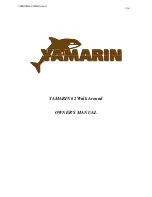
Hobie University, NAHCA
Page 51
31 Mar 02
TACTICS AND WIND SHIFTS
1.
If you are ahead, you should try to stay between the boat(s) behind you and the next mark.
2.
If you are behind, you should do exactly as the boat ahead and hope he makes a mistake.
3.
If you are ahead and must cover boats that tack to opposite sides of the course, you must choose the side to
cover either by the most formidable opponent(s) or by what you think is the favored side of the course, or
both.
4.
Persistent shifts are those that blow at you from the same direction all day long and persistently never change.
5.
Oscillating shifts are those that swing back and forth, but generally from the same overall direction.
6.
In a catamaran, wind velocity normally is more important than wind direction, if that direction variance is not
very large.
7.
Wind tends to cross over a shoreline at a more perpendicular angle to the shore than its normal direction. This
would be a geographical shift.
8.
Darker water on one side of the course usually indicates there is more wind on that side than on the other side,
and thereby that darker side could be considered the favored side of the course.
9.
Always stay on the beach until the last moment to conserve your energy; sailing up to the windward mark with
a buddy will only wear you out.
10. Always sail past the laylines far enough so that you don't ever have to worry about tacking anymore, no matter
what wind shifts come along.
Rick’s answers - 1.T, 2.F, 3.T, 4.F, 5.T, 6.T, 7.T, 8.T, 9.F, 10.F
Here is a brief discussion of my answers for the Performance Sailing Quiz on Tactics And Wind Shifts.
1.
If you are ahead, you should try to stay between the boat(s) behind you and the next mark.
True. If possible,
do not allow the boat(s) behind you to catch better wind than you. If they go to the left side of the course, you
go left with them, if they go right, you go right. For better or for worse, they will sail in approximately the
same wind as you, and thus they can't make a significant gain.
2.
If you are behind, you should do exactly as the boat ahead and hope he makes a mistake.
False. You will
find it difficult, if not impossible sailing in the same wind as your competitor, to pass him. Split tacks with
him. Tack to the other side of the course and hope for better winds. If you feel that you are already on the
best side of the course, sail more to the center as opposed to going to the side. If your competitor does not
match your tacks, you have a chance to get ahead.
3.
If you are ahead and must cover boats that tack to opposite sides of the course, you must choose the side to
cover either by the most formidable opponent(s) or by what you think is the favored side of the course, or both.
True. You can't cover both sides of the course, so you must decide who to cover. If it is early in a regatta,
you may chance your assessment of the favored side of the course. However, later in the regatta, it may be
more important to finish ahead of a certain opponent to preserve or improve your overall finish, thus cover
him.
4.
Persistent shifts are those that blow at you from the same direction all day long and persistently never change.
False. Persistent wind shifts are those that slowly clock or change in the same direction over hours.
Recognizing a persistent wind shift is a big advantage tactically.






































